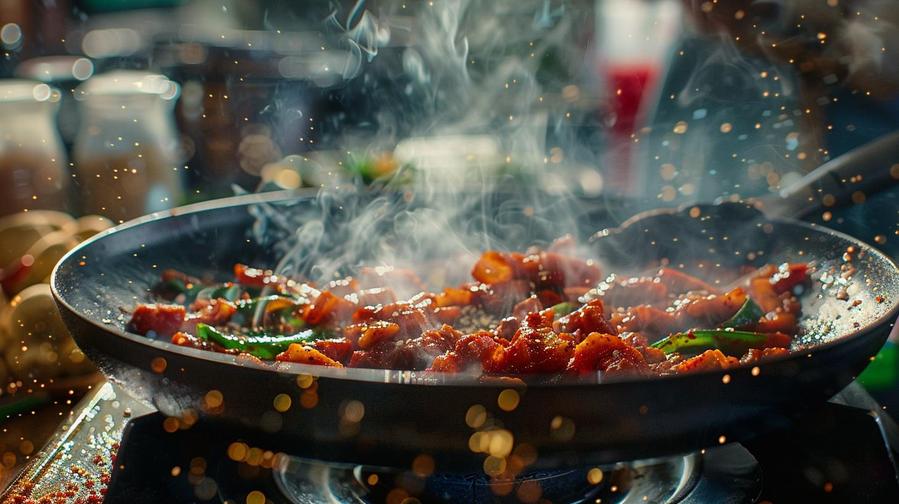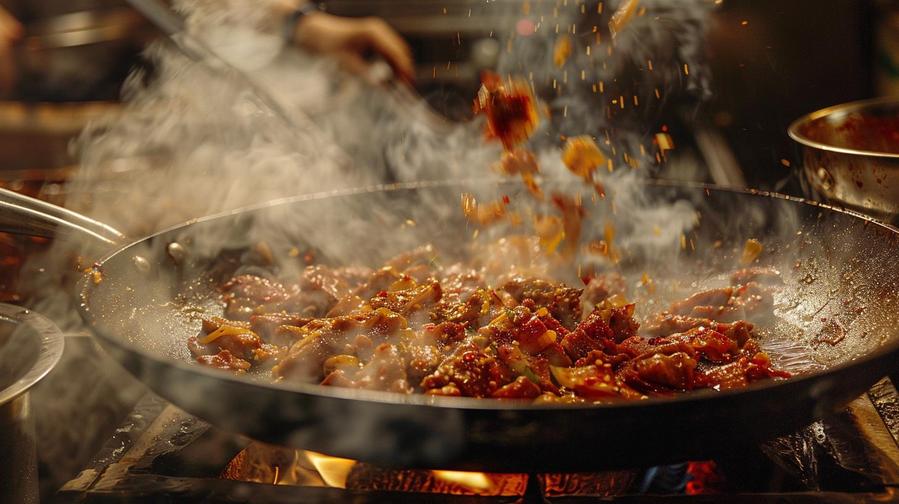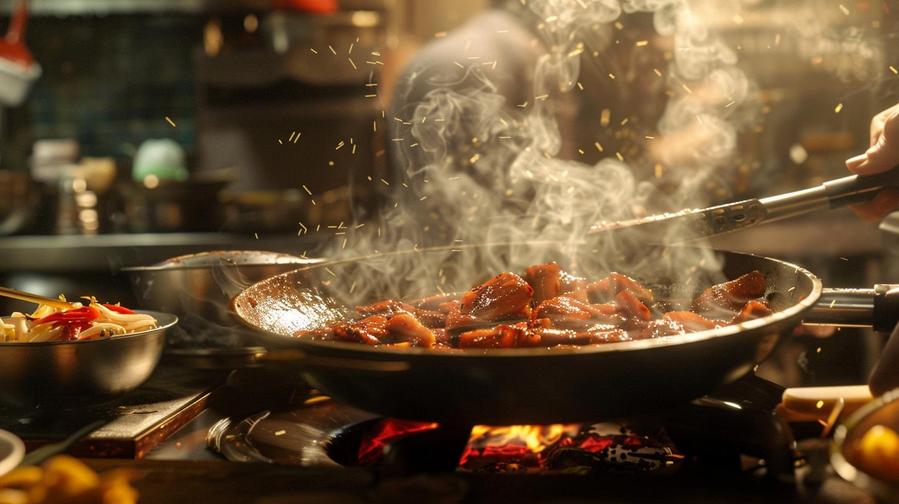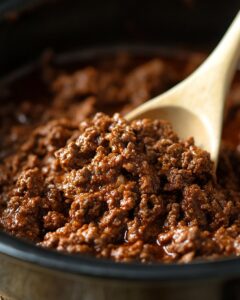Craving an explosion of flavors right in your kitchen? Our Spicy Korean Pork Recipe is your passport to a culinary adventure. This easy-to-follow guide will help you recreate this authentic, fiery delight at home. So, let's dive into the world of Korean cuisine, where simplicity meets taste!
TL;DR:
- The core of this savory Korean pork recipe lies in the marinade make-up: gochujang (Korean chili paste), soy sauce, white sugar, grated ginger, and sesame oil. Love heat? Increase the gochujang.
- Recipe substitutions include replacing pork with chicken thighs, adding or reducing ingredients based on personal taste.
- Ensuring the pork has adequate time in the marinade along with correct searing locks in flavor. Vegetables are added later due to quicker cook times.
- The dish can be paired with steamed rice, a side of kimchi, or even glass noodles for a twist. Pairings include both alcoholic and non-alcoholic beverages.
- Ideal storage in an airtight container gives leftovers a 3-4 day fridge life. These servings can also be frozen for up to a month.
- Tweaking the recipe to personal taste is encouraged, with suggestions like additional lemon juice or crushed peanuts.

Gathering the Ingredients
One of the joys of cooking is finding, and then grouping, all the parts of the recipe. Let's dive right into our spicy Korean pork recipe!
Complete Ingredient List
Here's what you need for this savory adventure:
- 500 g pork scotch fillet, thinly sliced
- 2 tablespoons vegetable oil
- 3 cloves garlic, minced
- 1 onion, sliced
- 1 shredded carrot
- 2 spring onions, chopped
- a sprinkling of sesame seeds
- Finely grated zest of 1 lemon
For the marinade, you will need:
- 2 tablespoons gochujang (fermented Korean chili paste)
- 2 tablespoons soy sauce
- 1 tablespoon white sugar
- 1 teaspoon grated ginger
- 2 teaspoons sesame oil
This list will make a spicy Korean pork stir fry, enough for 4 people.
Ingredient Substitutions
If you want to swap out the pork, chicken thighs are a great stand-in. There's no taste rule here; it's all about what you love!
Ingredient Variations
And guess what? You make your mark on this dish. Want it more spicy? Go heavy on the gochujang. But if you want to tame the heat, ease off the chili paste and add more shredded vegetables. You shape this spicy Korean pork recipe to your taste!
So there you have it. A heap of tangy, sizzling plates of delicious Korean pork awaits you. Now, grab those ingredients, and let's get cooking!
Preparing the Spicy Korean Pork
The first thing you need to know when preparing for your spicy Korean pork venture is that the pork being used should ideally be ribs or belly. The Korean spicy pork ribs recipe and spicy pork belly bulgogi you often hear about, use these cuts for a reason. They are tender and soak up flavor well. Specifically, the gochujang pork belly marinade is key.
Step-by-step Cooking Process
- Start by preparing the marinade. Mix gochujang, soy sauce, white sugar, grated ginger, and sesame oil in a bowl.
- Thinly slice your pork and let it soak in the marinade, ideally for an hour or two.
- Heat up some vegetable oil in a pan, then add garlic and onion, cooking until they become fragrant.
- Add your marinated pork into the pan, searing on all sides.
- After the pork is cooked, add in shredded carrot and spring onions, stir-frying them until they are well-cooked.
- Finish by garnishing the dish with sesame seeds and lemon zest.
Important Cooking Tips
When cooking the pork, make sure to sear it properly. This not only locks in flavor but also helps to render down the fat, making the meat juicier. Always add your vegetables last, as they cook much quicker than meat.
Alternative Cooking Methods
The dish can definitely be customized! For example, instead of stir-frying, you could grill the pork. This method would give the pork a wonderful smoky flavor that goes well with the spicy marinade.
Remember though, no matter how you choose to cook it, the total time required to prepare this dish is 15 minutes for preparation and 10 minutes for cooking. So, it can easily be your go-to quick dinner recipe!
Just imagine yourself now, journey to the world of spicy and umami flavors! So, are you ready to hit your kitchen and prepare this flavorful Spicy Korean Pork Stir-fry? Let's get cooking!
Related Recipes:

Serving and Pairing Suggestions
After following our spicy Korean stir-fry pork recipe, you may be wondering, "How can I serve it, and what goes well with it?" Good question!
Serving Suggestions
Serve your spicy Korean pork, freshly hot and glistening, over a generous portion of steamed rice. This dish is traditionally enjoyed with a big spoonful of kimchi on the side. However, if you enjoy the unexpected, why not substitute the rice with glass noodles for a fun and delicious twist?
Pairing with Sides
As this dish is quite savory and spicy, it pairs nicely with sweet and citrusy sides to balance out the flavor profile. For example, you could stir fry some bell peppers, zucchini, and rainbow chard for a punchy and nutritious accompaniment to the meat. Into seafood? Perhaps you could even try it with a Korean spicy pork and squid recipe for a unique surf n' turf Eastern style!
Beverage Pairings
With its strong and fiery flavors, a gulp of cold beverage can provide a needed relief! Pro tip: beer pairs exceptionally well with spicy dishes, and your homemade spicy Korean pork is no exception. Korean rice beers, in particular, offer a rich and creamy counterpoint to the dish. If alcoholic drinks aren't your thing, then a refreshing cucumber lime smoothie is a wonderful complement to this dish. It's sweet and tangy notes cool the heat, making it a great companion to any spicy dish.
In summary, whether using your favorite Korean pork Bulgogi recipe non-spicy or adding an extra kick to your own spicy version, perfect pairing lies in satisfying your personal palate and having fun with the flavors. Now, you are ready to serve and enjoy an authentic Korean dinner with your loved ones at home! Go to here for more side dish ideas!
Storing and Reheating
It's one thing to master the jeyuk bokkeum recipe and pronounce it like a pro, but storing and reheating this delicacy keeps it flavorful for the next meal.
Proper Storage Methods
For your leftover jeyuk bokkeum, make sure it cools down before keeping it in your fridge. Store the leftover in an airtight container and pop it in the fridge. This process should keep it fresh for up to 3-4 days. Remember, if you see a change in color or smell, it's better to play safe and discard it.
Reheating Instructions
Wondering how to bring back the vibrant textures of jeyuk bokkeum when reheating the dish? Start by transferring the leftovers in a pan over medium heat. Stir gently until the pork is warm. Remember to stir frequently to prevent the bottom from burning. Sprinkle some water if the dish seems dry.
Freezing and Thawing
Jeyuk bokkeum handles freezing pretty well. Transfer your leftovers into a freezer-safe container or heavy-duty freezer bags. This method can store your dish for up to one month. When you're ready to eat, thaw it in the refrigerator overnight. Remember to always reheat it properly before serving. Enjoy taking this flavorful journey to Korea right from your home kitchen!

Frequently Asked Questions
Common Queries
1. What is jeyuk bokkeum in Korean?
Jeyuk bokkeum is a popular Korean dish. It is spicy stir-fried pork that is both sweet and extremely flavorful.
2. What are the jeyuk bokkeum calories per serving?
Each serving roughly contains 300-400 calories, but it can vary based on the ingredients and portion sizes.
3. Where can I find jeyuk bokkeum near me?
Look for local Korean restaurants or food markets nearby. You can also visit this online Korean Food community for advice.
Recipe Adjustments
1. Can I replace pork with another type of meat in the recipe?
Yes, you can! You could use chicken thighs instead for a leaner option.
2. What can I do if the recipe is too spicy for me?
You can reduce the amount of gochujang, the Korean chilli paste, in the marinade.
Troubleshooting Tips
1. Why is my jeyuk bokkeum not flavorful enough?
The key to a flavorful jeyuk bokkeum is in the marinade. Make sure to mix it well and marinate the pork for at least an hour for the flavors to blend together.
2. The pork turned out dry. What went wrong?
Stir-frying for too long at high heat can dry out the pork. Try to cook on medium heat and only up until the pork is cooked through.
3. Can I refrigerate the leftover spicy Korean pork?
Yes. It's best consumed within 3-4 days but can last up to a week in a well-sealed container in the refrigerator.
Remember, if you have any more questions or need further help, don't hesitate to ask. Enjoy your cooking!
Making It Your Own
This jeyuk-deopbap recipe or jeyuk bokkeum bap for Spicy Korean Pork Stir-fry is rich in flavor and easy to make, but you can also switch things up to create a new twist on this dish.
Personalizing the Recipe
Just like you, this dish can be unique! Feel free to add or remove ingredients based on your own taste. Not a fan of carrot? No problem, you can leave it out. Do you love heat? Toss in extra gochujang.
Ingredient Swaps
A great swap is using chicken thighs instead of pork. It's a good option if you don't eat pork or simply fancy a change. You can also replace gochujang with other chili pastes if you want a less intense heat.
Recipe Variations
One great way to add more depth to the flavors is to add a splash of lemon juice to the marinade, introducing a slight tanginess that contrasts the spicy, sweet, and savory flavors. If you want to add more texture to the dish, sprinkle it with some crushed peanuts just before serving.
Remember, creating an easy Korean pork bulgogi recipe at home is all about the fusion of personal taste and tradition. So, feel free to play around and make this dish your own! Its versatility is what makes it a crowd favorite. Now, who's ready to start cooking?
In this post, we've explored how to craft a delicious spicy Korean pork dish, from gathering the right ingredients and perfecting the cooking process, to finding the best pairings and storage options. We've also addressed common questions and offered ways to personalize the recipe. Cooking should be a joy, not a chore. With these tips, you're well on your way to mastering this dish and making it your own. Remember, the best meals are those made with love and passion. Happy cooking!












